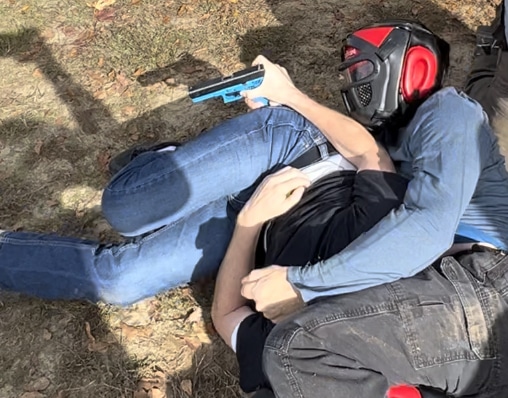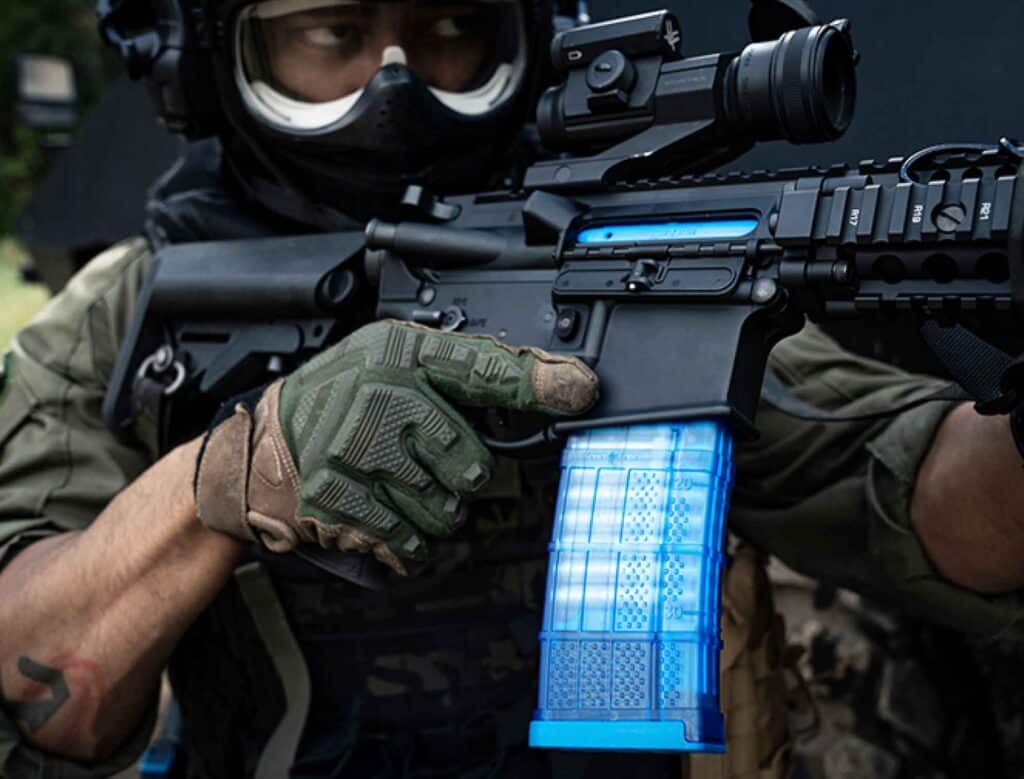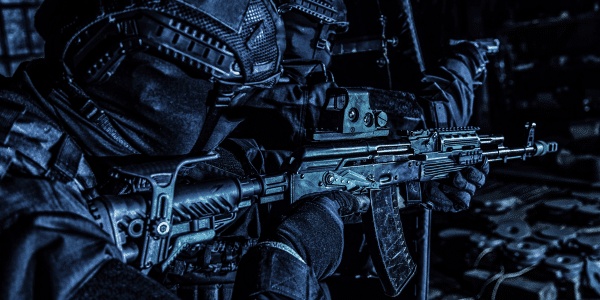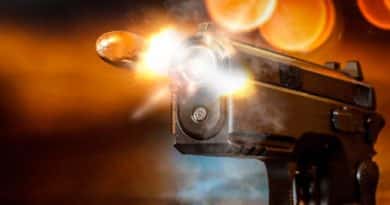Simulating Real Threats: The Dynamics of Force-on-Force Training
Jumping into the realm of force-on-force training opens the door to an exhilarating and immersive training experience like no other.
Imagine a scenario where split-second decisions matter, where communication and teamwork are paramount, and where the pulse-pounding realism of simulated engagements pushes individuals to their limits.
Force-on-force training, a dynamic and hands-on approach to preparedness in fields such as local police, law enforcement officers, military, and security, offers a thrilling opportunity to test and refine pistol and rifle skills in a controlled yet realistic environment that induces stress and fear.
This style of training has become increasingly popular as they use firearms that fire non-lethal rounds, similar to that of airsoft or paintball guns.
In this article, we will dive deeper into the essential aspects of force-on-force training, uncovering its importance, the skills it hones, and the safety measures that make it a transformative and indispensable advanced training tool for those seeking to excel in high-pressure situations, such as life-threatening and violent encounters as an armed citizen.
Table of contents
- What is Force-on-Force Training?
- Why is Force-on-Force Training Important?
- What Drills and Skills Are Focused on During Force-on-Force Training?
- What Do I Need for Force-on-Force Training for Self-Defense?
- What Are the Safety Precautions When Using a Firearm with UTM or Simunition Rounds?
- Does Getting Shot by UTM and Simunition Rounds During FOF Training Hurt?
- If You Can Find Force on Force Training — GET IT!
- *UPDATE: UTM and Simunition Rounds Are Now Regulated — What Does That Mean?
- FAQs

What is Force-on-Force Training?
Force-on-force training (also abbreviated as FOF) is a type of real-life firearms training that simulates real-world scenario-based training in a controlled environment, allowing trainees, typically in law enforcement, military, or security fields, to practice and refine their handgun or rifle skills in a dynamic and realistic setting and induces fear and stress.
The primary goal of force-on-force training is to provide a more immersive and interactive experience than traditional static training exercises through the help of a firearms instructor and trainer.
Key features of this type of training include:
1. Realistic Scenarios: Participants engage in scenario training that closely resembles situations they may encounter in the field (unlike traditional target training). These scenarios can range from active shooter situations to hostage rescues, and they often involve role players or instructors acting as both friendly and hostile entities. This training is much different from traditional firearms practice and shooting on a flat range at paper targets, as you have human adversaries coming after you in life-threatening situations.
2. Simulated Weapons and Ammunition: Instead of using live firearms and ammunition, force-on-force training scenarios typically employ simulated weapons and non-lethal ammunition for non-lethal training. These can include paintball guns, airsoft guns, or other training weapons that replicate the look and feel of real firearms. The ammunition used is designed to be non-lethal marker rounds but still provides a realistic impact, allowing participants to experience the stress and pressure of real-world engagements. These marker rounds chamber and fire like live rounds but fire non-lethal ammunition. The use of dedicated UTM firearms do not allow live ammunition to chamber, adding another layer of safety.
3. Protective Gear: Participants wear protective gear, such as helmets, goggles, and padded clothing, to minimize the risk of injury during training. This gear helps create a safe environment while allowing participants to experience the physical effects of being in a high-stress situation.
4. Immediate Feedback: Force-on-force training allows for immediate feedback and debriefing after each scenario. This feedback helps participants understand what worked well and what areas need improvement. It also enhances the learning experience by reinforcing correct techniques and decision-making. Improving upon your decision-making and problem-solving skills is key when put in a stressful situation where you need to act quickly. Constantly working on your skills will also help prevent tunnel vision when under stress of a life-threatening situation.
5. Decision-Making Training: Force-on-force scenarios often involve complex decision-making, requiring participants to assess threats who are a live opponent, make split-second decisions, and adapt to changing situations. This aspect of the training helps improve cognitive and tactical skills.
Force-on-force training cannot be forgotten as it is valuable for honing skills related to communication, teamwork, situational awareness, and tactical decision-making. It provides a bridge between static drills and real-world situations, helping individuals develop the muscle memory and mental resilience needed for effective performance in dynamic and high-pressure environments.
Related Article: Next Level Training SIRT Pistol — The Best Laser Dry Fire Tool?
I spoke with Zach Bush of Definitive Training Solutions and he said the following about FOF training:
Force-on-force should be used as a tool to evaluate the students knowledge. While force-on-force can teach us many lessons, it is best used in the evaluation role. In order to get the best evaluation for the student, the real-life or skills-based scenarios should be created with the proper end goal.
– Zach Bush of Definitive Training Solutions
Why is Force-on-Force Training Important?

Force-on-force training is important for several reasons, particularly in the fields of law enforcement, military, and security. Here are some key reasons why force-on-force training is considered valuable:
1. Realism and Immersion: Force-on-force training provides a more realistic and immersive role-play experience with actual people as moving targets compared to traditional static training exercises. By simulating real-world scenarios, participants can better prepare for the dynamic and unpredictable nature of actual operational environments and improve their self-defense skills.
2. Stress Inoculation: Force-on-force training exposes participants to stress and pressure, helping them develop the ability to perform effectively under challenging conditions. This stress inoculation is crucial for building mental resilience and ensuring that individuals can make sound decisions in high-pressure situations.
3. Decision-Making Skills: The scenarios in force-on-force training require participants to make quick and accurate decisions. This helps improve decision-making skills, situational awareness, and the ability to assess and respond to evolving threats in a fluid and dynamic environment.
4. Teamwork and Communication: Force-on-force exercises often involve teamwork and communication among participants. This type of training enhances the coordination and collaboration of individuals operating in a team, fostering better communication and mutual understanding of roles and responsibilities.
5. Tactical Proficiency: Participants can practice and refine tactical skills, including movement, cover, and engagement techniques, in a realistic setting. This hands-on experience contributes to the development of muscle memory and enhances overall tactical proficiency.
6. Equipment Familiarity: Force-on-force training allows participants to use simulated weapons and equipment similar to what they would use in the field. This helps familiarize them with the tools of their trade and ensures they are comfortable and proficient in the use of their gear.
7. Immediate Feedback and Debriefing: After each force-on-force scenario, participants receive immediate feedback and engage in debriefing sessions. This constructive feedback is crucial for identifying strengths and weaknesses, reinforcing good practices, and addressing areas that need improvement.
8. Legal and Ethical Considerations: Force-on-force training can incorporate scenarios that involve legal and ethical considerations, helping participants navigate complex situations within the bounds of the law and ethical guidelines. This is especially important in professions where the use of force is regulated.
9. Cost-Effective Training: While force-on-force training requires specialized equipment, simulated weapons, and protective gear, it can be more cost-effective than live-fire exercises. It allows for frequent and realistic training without the logistical challenges and expenses associated with live ammunition.
Overall, force-on-force training is a valuable tool for preparing individuals for the challenges they may face in their respective roles, ensuring that they are better equipped to handle real-world situations with skill, confidence, and professionalism.
What Drills and Skills Are Focused on During Force-on-Force Training?
Force-on-force training encompasses a variety of drills and skills to prepare participants for dynamic and realistic scenarios. The specific drills and skills focused on during force-on-force training can vary depending on the goals of the training program, the nature of the participants’ roles (e.g., law enforcement, military, security), and the scenarios being simulated. However, common elements include:
1. Firearms Handling and Marksmanship: Participants practice the safe and effective handling of firearms, including drawing from a holster, reloading, and transitioning between different weapons. Marksmanship skills are honed using simulated weapons that replicate the weight, feel, and recoil of real firearms.
2. Movement and Cover Techniques: Participants learn and practice movement techniques, including advancing, retreating, and lateral movement. They also develop skills related to using cover effectively, understanding angles, and maintaining situational awareness while on the move.
3. Decision-Making and Threat Assessment: Force-on-force scenarios present participants with various situations that require rapid decision-making. This includes assessing threats, distinguishing between hostile and non-hostile entities, and making split-second judgments about the use of force.
4. Communication Skills: Effective communication is crucial in high-stress situations. Participants practice clear and concise verbal commands, signaling, and coordination with team members. This helps ensure that everyone is on the same page and can respond cohesively to evolving situations.
5. Team Tactics: Force-on-force training often involves scenarios where participants work as a team to achieve specific objectives. This includes coordinating movements, covering sectors, and responding to threats as a cohesive unit. Team tactics emphasize collaboration and mutual support.
6. Close Quarters Battle (CQB) Techniques: For those in law enforcement and military roles, force-on-force training may include drills focused on CQB techniques. This involves engaging threats in confined spaces, such as buildings or vehicles, where traditional engagement strategies may not be applicable.
7. Non-Lethal Force Options: Participants practice the use of non-lethal force options, such as less-lethal projectiles, chemical agents, or conducted energy devices. This allows them to understand the capabilities and limitations of these tools and make informed decisions about their use in different scenarios.
8. Weapon Retention and Disarming: In scenarios where participants may come into physical contact with threats, they practice techniques for retaining control of their weapons and, conversely, disarming adversaries. This is especially relevant for law enforcement and security professionals.
9. Medical Training: Some force-on-force training programs incorporate medical training, teaching participants how to provide basic first aid and address injuries that may occur during simulated engagements.
10. Legal and Ethical Considerations: Scenarios may be designed to incorporate legal and ethical considerations, challenging participants to make decisions within the bounds of applicable laws and ethical guidelines.
Force-on-force training is versatile, and the drills and skills emphasized can be tailored to meet the specific training objectives of the participants and the organizations conducting the training. It provides a comprehensive approach to preparing individuals for the complexities of real-world situations in their respective roles.
What Do I Need for Force-on-Force Training for Self-Defense?
Participating in force-on-force training requires specific equipment to ensure safety, realism, and effective training. The exact requirements may vary depending on the training program and the type of force-on-force scenarios being conducted. However, here are some common elements and equipment typically needed for force-on-force training (some of the elements are the same as what was just mentioned):
1. Protective Gear:
- Helmet: A helmet provides head protection and may include a face shield or goggles for eye protection.
- Eye Protection: Goggles or a full-face shield to protect the eyes from simulated projectiles.
- Body Armor: Depending on the nature of the training, participants may wear padded clothing or body armor to reduce the risk of injury from impacts.
2. Clothing:
- Participants should wear appropriate clothing for the training environment. This may include long sleeves, long pants, gloves, and sturdy footwear.
3. Simulated Weapons:
- Training Firearms: Simulated firearms that replicate the weight, feel, and operation of real weapons. These can include airsoft guns, paintball markers, or other training firearms.
- Ammunition: Non-lethal, color-marking ammunition specific to the training firearms being used.
4. Holsters and Equipment:
- Participants may use holsters and carry equipment similar to what they use in their professional roles. This allows for realistic training in drawing and deploying their simulated weapons.
5. Communication Equipment:
- If communication is a component of the training, participants may use radios or other communication devices to coordinate with team members.

6. Medical Supplies:
- Basic first aid supplies may be necessary in case of minor injuries during training. This could include bandages, antiseptic wipes, and other first-aid essentials.
7. Training Environment:
- A controlled training environment, such as a specially designed facility or outdoor area, is essential for conducting force-on-force scenarios. The environment should be adaptable to different scenarios and provide cover and concealment options.
8. Instructors and Safety Officers:
- Trained instructors and safety officers are crucial for overseeing the training, providing guidance, and ensuring the safety of participants. They play a key role in scenario development, execution, and debriefing.
9. Debriefing Tools:
- Video recording equipment or other tools for debriefing and reviewing participant performance after each scenario.
10. Legal and Safety Briefings:
- Participants should receive thorough briefings on safety protocols, the rules of engagement, and any legal or ethical considerations relevant to the scenarios.
Before participating in force-on-force training, individuals should check with the training organizers to understand specific equipment requirements and guidelines. It’s essential to adhere to safety protocols and use appropriate protective gear to minimize the risk of injury during simulated engagements. Additionally, participants should be familiar with the rules and objectives of each scenario to ensure a productive and safe training experience.
What Are the Safety Precautions When Using a Firearm with UTM or Simunition Rounds?
Safety is paramount when using Ultimate Training Munitions (UTM) or simunition rounds in force-on-force training. This specialized training ammunition is designed to provide a realistic simulation of live-fire scenarios while minimizing the risk of injury. Here are some key safety precautions to consider when using UTM or simunition rounds:
1. Protective Gear:
- Eye Protection: Ensure that all participants and instructors wear appropriate eye protection, such as goggles or a full-face shield, to prevent eye injuries from projectiles.
- Head Protection: Participants should wear helmets to protect the head from impacts.
2. Clothing:
- Participants should wear appropriate clothing, including long sleeves, long pants, and a quality pair of gloves, to minimize the risk of skin abrasions or bruises.
3. Body Armor:
- Depending on the training scenario and the type of UTM or simunition rounds used, participants may wear padded clothing or body armor to reduce the impact of projectiles.
4. Firearm Safety:
- Treat UTM or simunition firearms with the same level of respect and adherence to safety rules as live firearms.
- Participants should follow strict muzzle discipline and keep the firearm pointed in a safe direction at all times.
- Only point the firearm at individuals participating in the scenario, and do not aim at unauthorized personnel, observers, or instructors.
5. Clearing Procedures:
- Implement strict clearing procedures before and after each scenario. Ensure that all live firearms and live ammunition are removed from the training area.
- Conduct a thorough check to ensure that only UTM or simunition rounds are used during force-on-force training.
6. Mandatory Safety Briefing:
- Before the start of any force-on-force training, conduct a comprehensive safety briefing. This briefing should cover safety rules, the use of protective gear, emergency procedures, and any specific rules or guidelines for the training session.
7. Range Safety Officers:
- Assign qualified range safety officers or instructors to oversee the training. These individuals should have the authority to stop or modify scenarios if safety concerns arise.
8. Minimum Engagement Distances:
- Establish minimum engagement distances to prevent injuries at close range. Ensure that participants are aware of these distances and understand the appropriate use of force at various ranges.
9. Medical Support:
- Have medical personnel or first aid kits readily available in case of injuries. Train participants in basic first aid and establish protocols for addressing injuries during force-on-force training.
10. Emergency Procedures:
- Develop and communicate emergency procedures for various scenarios, including medical emergencies, accidental discharges, or other unexpected incidents.
11. Inspection of Equipment:
- Regularly inspect and maintain UTM or simunition firearms and ammunition to ensure they are in proper working condition.
12. Adherence to Rules of Engagement:
- Clearly define and communicate rules of engagement to participants, emphasizing the appropriate use of force and the boundaries of the scenarios.
By diligently following these safety precautions, training organizers can create a controlled and secure environment for force-on-force training with UTM or simunition rounds, minimizing the risk of injuries while providing realistic and effective training experiences.
Does Getting Shot by UTM and Simunition Rounds During FOF Training Hurt?
Yes, getting shot by UTM (Ultimate Training Munitions) or simunition rounds during FOF scenarios can cause pain, discomfort, and leave a welt. While these training rounds are designed to be less lethal than live ammunition, they still deliver a kinetic impact, and individuals who are hit may experience a stinging sensation, bruising, or welts. The intensity of the impact can vary based on factors such as the distance from which the round is fired, the type of protective gear worn, and the individual’s sensitivity to pain.
To mitigate the risk of injury and enhance safety during FOF classes with UTM or simunition rounds, participants typically wear protective gear, such as face and eye protection. This gear often includes helmets, eye protection, and padded clothing or body armor. The protective measures help reduce the likelihood of serious injury while allowing for a realistic simulation of live-fire scenarios.
It’s important to note that force-on-force training is designed to be a controlled and supervised environment. Trained instructors and safety officers closely monitor the exercises, and strict safety protocols are in place to minimize risks. Additionally, participants are typically briefed on safety guidelines and rules of engagement before participating in force-on-force scenarios.
Related Article: Tremis Dyamics FISH Class — Fighting in Someone’s House
While the use of UTM or simunition rounds can cause some discomfort, the primary goal of force-on-force training is to provide realistic and immersive experiences that allow participants to practice and refine their skills in a safe and controlled setting. The use of these specialized training rounds helps bridge the gap between static drills and live-fire exercises, offering valuable opportunities for skill development and decision-making in dynamic scenarios.
If You Can Find Force on Force Training — GET IT!
To wrap things up and put a bow on this article, force-on-force training stands as an indispensable component in the development and preparedness of individuals in roles such as law enforcement, military, and security. It provides a stronger physiological stress reaction than what you would find on a flat range with live fire training.
The immersive and dynamic nature of this training provides a realistic simulation of high-stress scenarios, allowing participants to refine their skills in decision-making, communication, and tactical proficiency.
By bridging the gap between static drills and real-world situations, force-on-force training cultivates the mental resilience necessary to perform under pressure. It serves as a vital tool for honing not only technical skills but also fostering teamwork, situational awareness, and adherence to legal and ethical considerations.
Related Article: Zach Bush of Definitive Training Solutions — Be Harder to Kill
Ultimately, the necessity of force-on-force training lies in its ability to prepare individuals to navigate the complexities of their roles with competence, ensuring a more effective and safer response to the challenges they may encounter in their professional environments. If you’re looking for any classes that still offer FOF training, check out Bulletn to find classes in your area or throughout the US where you can get some training.
I spoke with Garry Marr of Tremis Dynamics and he provided me with the below:
Force-on-force training is orders of magnitude more valuable to a student than live-fire training. With force-on-force equipment, one could teach most of the same things that are taught in a traditional Pistol class. All the manipulations are the same with the proper equipment. And most of the skills are the same. Recoil management is the only one that really needs live fire.
That covers one of the four tenets of the Hierarch of Survival Principles. Skill. In order, those are:
– Mindset
– Tactics
– Skills
– Gear
The reason (pre-2023) that wasn’t done is the logistics of providing that gear. It’s not readily available to all students, and for those certified to use it, it’s exponentially more expensive than live-fire.
As we delve further into that hierarchy, Tactics dwarfs Skills. When Tactics are taught on a traditional square range, the theory of those tactics is taught. With force on force, they are applied against a resisting opponent. That means they are continually pressure tested, allowing the participant to validate those tactics as they hone them.
At the very top is Mindset. The willingness to do the right thing at the right time. This is not the easiest thing to teach in a class, but with the proper scenario-based Force on Force class, one can test where they currently have their mindset, giving them the correct feedback for how they need to change their decision-making processes. This simply cannot be done without trained role-players as the ‘bad guys’ to give the students live resistance to their decisions.
Recently, the BATFE banned the importation of NLTA for sale to normal citizens. It can still be sold to government entities. This is one of many terrible actions perpetuated by this unconstitutional agency. I don’t know if their reasoning is nefarious in that they don’t want citizens trained to be able to defend themselves or if it’s just a childish tantrum because they have a perfect losing record recently in the courts with their attempts at infringing on ‘we the people.’ Either way, it is unbecoming to an agency that wears an American flag on their uniforms.Currently, all NLTA is imported, so hopefully, an American manufacturer will start working with, or license the rights from, the two main companies who manufacture force-on-force equipment so we can get this type of training back in the hands of the public.
– Garry Marr of Tremis Dynamics
*UPDATE: UTM and Simunition Rounds Are Now Regulated — What Does That Mean?
The ATF likes to put its thumb on everything that allows civilians the ability to train and get more skilled with their firearms. In their latest move, they forced UTM to cease all sales to civilians in the US. This came as a press release to the industry through UTM in October 2023.
Essentially, what this is going to do is not only hurt the sales from UTM, but it’s going to end all force-on-force classes that firearms instructors teach. That’s going to drastically hurt their overall revenue and even potentially cause them to go out of business if they cannot pivot their business structure and class offerings.
The regulation of UTM or simunition rounds represents a potential shift in the oversight and management of specialized training munitions. While more hasn’t been said, I’d assume that eventually, they will be allowed for sale, but this may involve special licensing requirements, usage restrictions, safety standards, record-keeping obligations, and perhaps training and certification mandates.
Related Article: Strategic Support — Choosing and Using the Ideal Rifle Sling
Individuals and entities involved in force-on-force training with UTM or simunition rounds must stay informed about any new regulations, ensuring compliance with the evolving legal landscape to maintain the safety and effectiveness of such training practices. For the most accurate and current information, individuals should consult relevant authorities and legal professionals familiar with any recent legislative changes in this domain.
As a side note to close out this article, if you want to support our website and are in need of any tactical gear (or any product for that matter), anything you purchase using our links below will provide us with a small commission. We don’t charge for our free content and our goal is to keep it that way. We don’t have a Patreon account to put things behind a paywall, nor do we sell pics of our feet on OnlyFans.
If you choose to use the links below and make a purchase (at no additional cost to you), we greatly appreciate your support as it helps us continue to publish free content (like this article) on our website:
- Optics Planet (use code SAS5 at checkout for 5% off)
- Amazon
We have also partnered with CCW Safe. It’s the concealed carry coverage that I personally have for myself and my family in the event we need to defend our lives. Feel free to use our CCW Safe link to sign up and get some coverage to protect yourself and your family.
Also if you have a product you would like us to check out and potentially review, please contact us and let’s discuss.
FAQs
Force-on-force training is a dynamic and immersive approach to training, simulating real-world scenarios using non-lethal ammunition and realistic scenarios. This type of training is a critical strategy commonly employed in law enforcement, military, and security fields to enhance skills and preparedness.
Force-on-force training is crucial for honing decision-making skills, tactical proficiency, and teamwork in realistic, high-stress scenarios. It provides an effective bridge between static drills and actual situations, preparing individuals to navigate complex challenges with competence.
Force-on-force training emphasizes skills such as firearms handling, movement and cover techniques, decision-making under pressure, communication, teamwork, and adherence to legal and ethical considerations.
Participants require protective gear such as helmets, eye protection, and body armor. Simulated weapons, ammunition specific to force-on-force training (like UTM or simunition rounds), and communication equipment may also be used.
Yes, individuals may experience a stinging sensation, bruising, or discomfort when hit by UTM or simunition rounds. Protective gear, including helmets and padded clothing, is typically worn to minimize the risk of injury.
Regulations may vary, and it’s essential to stay informed about any specific laws or guidelines pertaining to UTM or simunition rounds. Regulations could cover licensing, safety standards, usage restrictions, and record-keeping requirements.
Force-on-force training is necessary for its ability to provide realistic, hands-on experiences that prepare individuals for the challenges they may face in their professional roles. It fosters the development of essential skills and mental resilience required in dynamic and high-pressure environments.
Individuals should regularly check with relevant authorities, law enforcement agencies, or legal professionals to stay informed about any changes in regulations pertaining to force-on-force training. This ensures compliance with evolving legal standards and safety guidelines.


*Disclosure: This article may contain affiliate links or ads, which means we earn a small commission at no extra cost to you if you make a purchase through these links. These commissions help support the operation and maintenance of our website, allowing us to continue producing free valuable content. Your support is genuinely appreciated, whether you choose to use our links or not. Thank you for being a part of our community and enjoying our content.
PLEASE CONSIDER SHARING THIS ON YOUR SOCIAL MEDIA TO HELP OTHERS LEARN MORE ABOUT THIS TOPIC.





